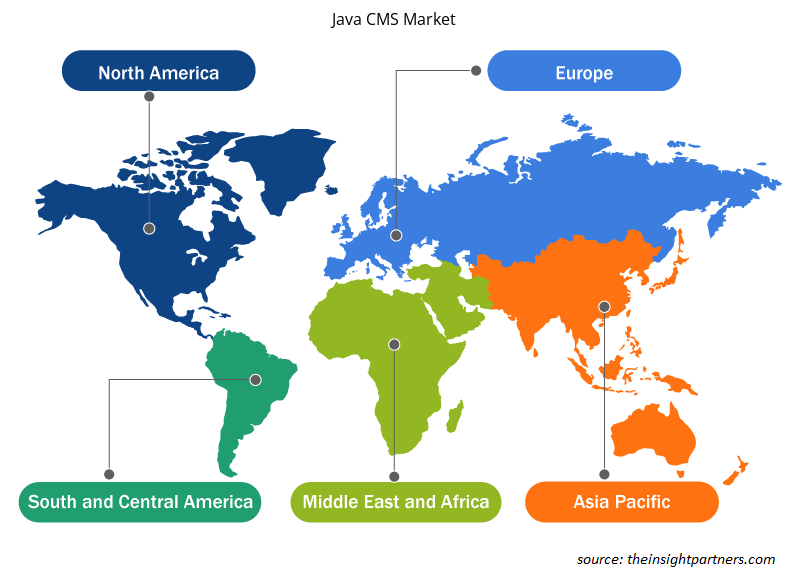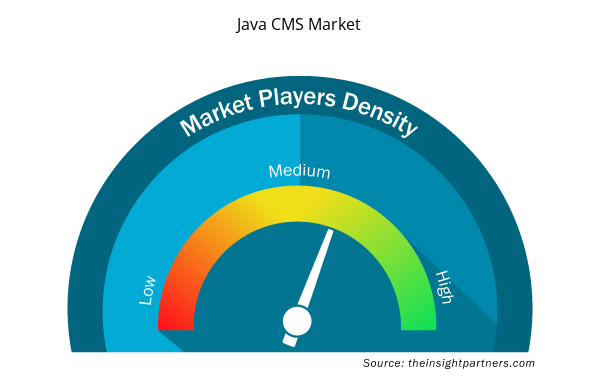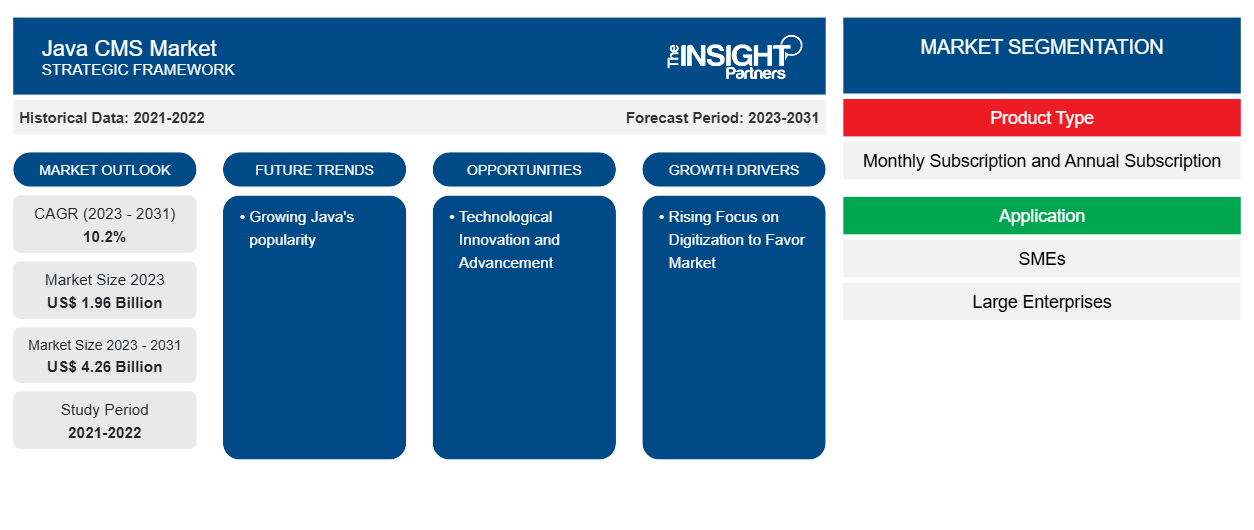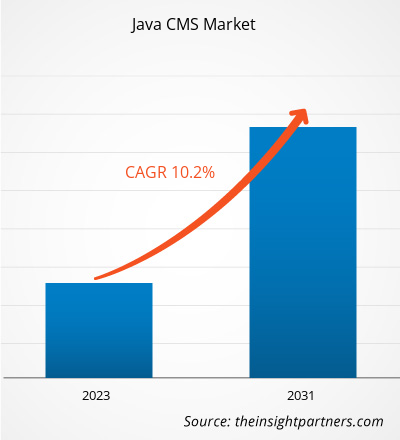من المتوقع أن ينمو حجم سوق Java CMS العالمي من 1.96 مليار دولار أمريكي في عام 2023 إلى 4.26 مليار دولار أمريكي بحلول عام 2031؛ ومن المتوقع أن يتوسع بمعدل نمو سنوي مركب قدره 10.2٪ من عام 2023 إلى عام 2031. ومن المرجح أن تظل الشعبية المتزايدة لـ Java التي تُعزى إلى متانتها وموثوقيتها وقدرتها على العمل على منصات متعددة من الاتجاهات الرئيسية لسوق Java CMS.
تحليل سوق Java CMS
تركز الشركات في مختلف الصناعات بشكل متزايد على التحول الرقمي. يعد تبني التقنيات والحلول الرقمية أمرًا ضروريًا للشركات لتظل قادرة على المنافسة في السوق الحديثة، وهو أحد العوامل الرئيسية التي تدفع سوق Java CMS.
نظرة عامة على سوق Java CMS
برنامج Java Content Management System (CMS) هو أداة قوية تمكن الشركات من إدارة وتحديث محتوى موقعها على الويب بكفاءة. بفضل واجهته سهلة الاستخدام وميزاته القوية، يعمل برنامج Java CMS على تبسيط عملية إنشاء المحتوى ونشره، مما يسمح للشركات بالحفاظ بسهولة على وجود ديناميكي على الإنترنت. يعمل برنامج Java CMS على تمكين الشركات من إنشاء صفحات الويب وتخصيصها وإدارة محتوى الوسائط المتعددة وتحسين ظهور محرك البحث. بفضل إمكانيات إدارة سير العمل البديهية ، يمكن للفرق التعاون بسلاسة في مهام إنشاء المحتوى ونشره، مما يعزز الإنتاجية ويقلل من الوقت المستغرق لطرح المنتج في السوق.
قم بتخصيص هذا التقرير ليناسب متطلباتك
ستحصل على تخصيص لأي تقرير - مجانًا - بما في ذلك أجزاء من هذا التقرير، أو تحليل على مستوى الدولة، وحزمة بيانات Excel، بالإضافة إلى الاستفادة من العروض والخصومات الرائعة للشركات الناشئة والجامعات
- احصل على أهم اتجاهات السوق الرئيسية لهذا التقرير.ستتضمن هذه العينة المجانية تحليلاً للبيانات، بدءًا من اتجاهات السوق وحتى التقديرات والتوقعات.
محركات وفرص سوق Java CMS
التركيز المتزايد على التحول الرقمي لصالح السوق
تلعب الرقمنة دورًا حاسمًا في نمو ونجاح الشركات في مختلف الصناعات. من خلال تبني التقنيات والحلول الرقمية، يمكن للمؤسسات إدارة وتوزيع المحتوى الرقمي بشكل فعال، وهو أمر ضروري للبقاء في المنافسة في السوق الحديثة. تفتح الرقمنة قنوات اتصال جديدة للشركات. من خلال التقنيات الرقمية، يمكن للمؤسسات التواصل مع العملاء وجمع رؤى قيمة. هذا يمكّن الشركات من التعلم من عملائها ومنافسيها، مما يؤدي إلى تحسين المنتجات والخدمات.
الابتكار والتقدم التكنولوجي
تلعب الابتكارات والتقدمات التكنولوجية دورًا مهمًا في دفع سوق برامج Java CMS. تعمل التطورات المستمرة في التكنولوجيا على تحسين أداء البرنامج، مما يجعله مستخدمًا على نطاق واسع في التطبيقات اللاحقة. تعمل هذه التطورات على تعزيز قدرات برنامج Java CMS وتساهم في نموه. علاوة على ذلك، يؤدي الابتكار التكنولوجي إلى تطوير واجهات سهلة الاستخدام وتدفقات عمل بديهية في برنامج Java CMS . تعمل هذه التحسينات على تحسين تجربة المستخدم، مما يجعل من السهل على المستخدمين التنقل واستخدام البرنامج.
تقرير تحليل تجزئة سوق Java CMS
إن القطاعات الرئيسية التي ساهمت في اشتقاق تحليل سوق Java CMS هي نوع المنتج والتطبيق.
- بناءً على نوع المنتج، ينقسم السوق إلى اشتراك شهري واشتراك سنوي. احتلت شريحة الاشتراك السنوي حصة سوقية أكبر في عام 2023.
- بناءً على التطبيق، ينقسم السوق إلى الشركات الصغيرة والمتوسطة الحجم والشركات الكبيرة. احتلت شريحة الشركات الكبيرة حصة سوقية أكبر في عام 2023.
تحليل حصة سوق Java CMS حسب المنطقة الجغرافية
ينقسم النطاق الجغرافي لتقرير سوق Java CMS بشكل أساسي إلى خمس مناطق: أمريكا الشمالية، ومنطقة آسيا والمحيط الهادئ، وأوروبا، والشرق الأوسط وأفريقيا، وأمريكا الجنوبية/أمريكا الجنوبية والوسطى. سيطرت أمريكا الشمالية على سوق Java CMS في عام 2023. إن الرقمنة المتزايدة للشركات والمؤسسات في أمريكا الشمالية هي محرك مهم لسوق Java CMS. أمريكا الشمالية هي المنطقة الأكثر تقدمًا من الناحية التكنولوجية، مع اقتصادات كبيرة مثل الولايات المتحدة وكندا والمكسيك. تساهم التطورات التكنولوجية المستمرة ومعدلات انتشار الرقمنة العالية (~81٪) في جميع أنحاء المنطقة في نمو سوق برامج Java CMS في أمريكا الشمالية.
رؤى إقليمية حول سوق Java CMS
لقد قام المحللون في Insight Partners بشرح الاتجاهات والعوامل الإقليمية المؤثرة على سوق Java CMS طوال فترة التوقعات بشكل شامل. يناقش هذا القسم أيضًا قطاعات سوق Java CMS والجغرافيا في جميع أنحاء أمريكا الشمالية وأوروبا ومنطقة آسيا والمحيط الهادئ والشرق الأوسط وأفريقيا وأمريكا الجنوبية والوسطى.

- احصل على البيانات الإقليمية المحددة لسوق Java CMS
نطاق تقرير سوق Java CMS
| سمة التقرير | تفاصيل |
|---|---|
| حجم السوق في عام 2023 | 1.96 مليار دولار أمريكي |
| حجم السوق بحلول عام 2031 | 4.26 مليار دولار أمريكي |
| معدل النمو السنوي المركب العالمي (2023 - 2031) | 10.2% |
| البيانات التاريخية | 2021-2022 |
| فترة التنبؤ | 2023-2031 |
| القطاعات المغطاة | حسب نوع المنتج
|
| المناطق والدول المغطاة | أمريكا الشمالية
|
| قادة السوق وملفات تعريف الشركات الرئيسية |
|
كثافة اللاعبين في السوق: فهم تأثيرها على ديناميكيات الأعمال
يشهد سوق Java CMS نموًا سريعًا، مدفوعًا بالطلب المتزايد من المستخدم النهائي بسبب عوامل مثل تفضيلات المستهلك المتطورة والتقدم التكنولوجي والوعي المتزايد بفوائد المنتج. ومع ارتفاع الطلب، تعمل الشركات على توسيع عروضها والابتكار لتلبية احتياجات المستهلكين والاستفادة من الاتجاهات الناشئة، مما يؤدي إلى زيادة نمو السوق.
تشير كثافة اللاعبين في السوق إلى توزيع الشركات أو المؤسسات العاملة في سوق أو صناعة معينة. وهي تشير إلى عدد المنافسين (اللاعبين في السوق) الموجودين في مساحة سوق معينة نسبة إلى حجمها أو قيمتها السوقية الإجمالية.
الشركات الرئيسية العاملة في سوق Java CMS هي:
- شركة ألكاكون للبرمجيات المحدودة وشركاه
- أميتيس
- شركة بلومريتش
- شركة آي بي إم
- شركة DOTCMS
- شركة كرافتر للبرمجيات.
إخلاء المسؤولية : الشركات المذكورة أعلاه ليست مرتبة بأي ترتيب معين.

- احصل على نظرة عامة على أهم اللاعبين الرئيسيين في سوق Java CMS
أخبار سوق Java CMS والتطورات الأخيرة
يتم تقييم سوق Java CMS من خلال جمع البيانات النوعية والكمية بعد البحث الأولي والثانوي، والذي يتضمن منشورات الشركات المهمة وبيانات الجمعيات وقواعد البيانات. فيما يلي قائمة بالتطورات في السوق:
- في سبتمبر 2023، نجح فريق الهندسة التابع لشركة IBM في الهند في تطوير حل الذكاء الاصطناعي الذي يتيح التحويل السلس لكود Cobol إلى Java، مما يوفر للشركات أداة قوية لتحديث أنظمة البرامج الخاصة بها.
(المصدر: بيان صحفي لشركة IBM، 2023)
تغطية تقرير سوق Java CMS والمنتجات النهائية
يوفر تقرير "حجم سوق Java CMS والتوقعات (2021-2031)" تحليلاً مفصلاً للسوق يغطي المجالات التالية:
- حجم السوق والتوقعات على المستويات العالمية والإقليمية والوطنية لجميع قطاعات السوق الرئيسية التي يغطيها النطاق
- ديناميكيات السوق مثل المحركات والقيود والفرص الرئيسية
- الاتجاهات المستقبلية الرئيسية
- تحليل مفصل لقوى PEST/Porter الخمس وSWOT
- تحليل السوق العالمي والإقليمي الذي يغطي اتجاهات السوق الرئيسية واللاعبين الرئيسيين واللوائح والتطورات الأخيرة في السوق
- تحليل المشهد الصناعي والمنافسة الذي يغطي تركيز السوق، وتحليل خريطة الحرارة، واللاعبين البارزين، والتطورات الأخيرة
- ملفات تعريف الشركة التفصيلية
- التحليل التاريخي (سنتان)، السنة الأساسية، التوقعات (7 سنوات) مع معدل النمو السنوي المركب
- تحليل PEST و SWOT
- حجم السوق والقيمة / الحجم - عالميًا وإقليميًا وقطريًا
- الصناعة والمنافسة
- مجموعة بيانات Excel



Report Coverage
Revenue forecast, Company Analysis, Industry landscape, Growth factors, and Trends

Segment Covered
This text is related
to segments covered.

Regional Scope
North America, Europe, Asia Pacific, Middle East & Africa, South & Central America

Country Scope
This text is related
to country scope.
الأسئلة الشائعة
The Java CMS market size is expected to grow from US$ 1.96 billion in 2023 to US$ 4.26 billion by 2031; it is anticipated to expand at a CAGR of 10.2% from 2024 to 2031.
The adoption of digital technologies and solutions is essential for businesses to stay competitive in the modern market which is among the major factors driving the Java CMS market.
The growing Java popularity is attributed to its robustness, reliability, and ability to run on multiple platforms are likely to remain a key Java CMS market trends.
The key players holding the majority of shares in the global Alkacon Software GmbH & Co. KG, AMETYS, Bloomreach Inc., IBM Corporation, and Dotcms Inc.
The global Java CMS market is expected to reach US$ 4.26 billion by 2031.
Trends and growth analysis reports related to Technology, Media and Telecommunications : READ MORE..
The Insight Partners performs research in 4 major stages: Data Collection & Secondary Research, Primary Research, Data Analysis and Data Triangulation & Final Review.
- Data Collection and Secondary Research:
As a market research and consulting firm operating from a decade, we have published and advised several client across the globe. First step for any study will start with an assessment of currently available data and insights from existing reports. Further, historical and current market information is collected from Investor Presentations, Annual Reports, SEC Filings, etc., and other information related to company’s performance and market positioning are gathered from Paid Databases (Factiva, Hoovers, and Reuters) and various other publications available in public domain.
Several associations trade associates, technical forums, institutes, societies and organization are accessed to gain technical as well as market related insights through their publications such as research papers, blogs and press releases related to the studies are referred to get cues about the market. Further, white papers, journals, magazines, and other news articles published in last 3 years are scrutinized and analyzed to understand the current market trends.
- Primary Research:
The primarily interview analysis comprise of data obtained from industry participants interview and answers to survey questions gathered by in-house primary team.
For primary research, interviews are conducted with industry experts/CEOs/Marketing Managers/VPs/Subject Matter Experts from both demand and supply side to get a 360-degree view of the market. The primary team conducts several interviews based on the complexity of the markets to understand the various market trends and dynamics which makes research more credible and precise.
A typical research interview fulfils the following functions:
- Provides first-hand information on the market size, market trends, growth trends, competitive landscape, and outlook
- Validates and strengthens in-house secondary research findings
- Develops the analysis team’s expertise and market understanding
Primary research involves email interactions and telephone interviews for each market, category, segment, and sub-segment across geographies. The participants who typically take part in such a process include, but are not limited to:
- Industry participants: VPs, business development managers, market intelligence managers and national sales managers
- Outside experts: Valuation experts, research analysts and key opinion leaders specializing in the electronics and semiconductor industry.
Below is the breakup of our primary respondents by company, designation, and region:

Once we receive the confirmation from primary research sources or primary respondents, we finalize the base year market estimation and forecast the data as per the macroeconomic and microeconomic factors assessed during data collection.
- Data Analysis:
Once data is validated through both secondary as well as primary respondents, we finalize the market estimations by hypothesis formulation and factor analysis at regional and country level.
- Macro-Economic Factor Analysis:
We analyse macroeconomic indicators such the gross domestic product (GDP), increase in the demand for goods and services across industries, technological advancement, regional economic growth, governmental policies, the influence of COVID-19, PEST analysis, and other aspects. This analysis aids in setting benchmarks for various nations/regions and approximating market splits. Additionally, the general trend of the aforementioned components aid in determining the market's development possibilities.
- Country Level Data:
Various factors that are especially aligned to the country are taken into account to determine the market size for a certain area and country, including the presence of vendors, such as headquarters and offices, the country's GDP, demand patterns, and industry growth. To comprehend the market dynamics for the nation, a number of growth variables, inhibitors, application areas, and current market trends are researched. The aforementioned elements aid in determining the country's overall market's growth potential.
- Company Profile:
The “Table of Contents” is formulated by listing and analyzing more than 25 - 30 companies operating in the market ecosystem across geographies. However, we profile only 10 companies as a standard practice in our syndicate reports. These 10 companies comprise leading, emerging, and regional players. Nonetheless, our analysis is not restricted to the 10 listed companies, we also analyze other companies present in the market to develop a holistic view and understand the prevailing trends. The “Company Profiles” section in the report covers key facts, business description, products & services, financial information, SWOT analysis, and key developments. The financial information presented is extracted from the annual reports and official documents of the publicly listed companies. Upon collecting the information for the sections of respective companies, we verify them via various primary sources and then compile the data in respective company profiles. The company level information helps us in deriving the base number as well as in forecasting the market size.
- Developing Base Number:
Aggregation of sales statistics (2020-2022) and macro-economic factor, and other secondary and primary research insights are utilized to arrive at base number and related market shares for 2022. The data gaps are identified in this step and relevant market data is analyzed, collected from paid primary interviews or databases. On finalizing the base year market size, forecasts are developed on the basis of macro-economic, industry and market growth factors and company level analysis.
- Data Triangulation and Final Review:
The market findings and base year market size calculations are validated from supply as well as demand side. Demand side validations are based on macro-economic factor analysis and benchmarks for respective regions and countries. In case of supply side validations, revenues of major companies are estimated (in case not available) based on industry benchmark, approximate number of employees, product portfolio, and primary interviews revenues are gathered. Further revenue from target product/service segment is assessed to avoid overshooting of market statistics. In case of heavy deviations between supply and demand side values, all thes steps are repeated to achieve synchronization.
We follow an iterative model, wherein we share our research findings with Subject Matter Experts (SME’s) and Key Opinion Leaders (KOLs) until consensus view of the market is not formulated – this model negates any drastic deviation in the opinions of experts. Only validated and universally acceptable research findings are quoted in our reports.
We have important check points that we use to validate our research findings – which we call – data triangulation, where we validate the information, we generate from secondary sources with primary interviews and then we re-validate with our internal data bases and Subject matter experts. This comprehensive model enables us to deliver high quality, reliable data in shortest possible time.


 احصل على عينة مجانية لهذا التقرير
احصل على عينة مجانية لهذا التقرير